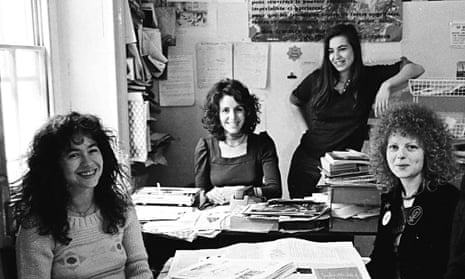To be honest, I can’t remember a single thing about the contents of this book. Mind you, that’s true of many books I’ve read. I do know that I borrowed it from my girlfriend Sally when we were students at Oxford in the early 1980s, along with Kate Millett’s Sexual Politics and Germaine Greer’s The Female Eunuch.
What I do remember is that the Spare Rib Reader felt very different from those other books. It had a slightly scruffy, home-made feel about it, more real, more down to earth. All three books grew out of the women’s movement, obviously, but the Reader felt like a team effort – not just a woman’s voice but the voices of many women, the voice of the movement itself, a record of something important happening out there in the world.
It doesn’t really matter that I can’t remember the contents. What matters is the effect that it had on me. I’d never read a book about politics of any kind. I’d certainly never read a book about feminism. In fact I can’t remember reading a single book written by a woman before the age of 18 (being a science-obsessed boy growing up in the 1970s skews it a little, but even so ...).
I’d grown up on a diet of Carry On films, Benny Hill and my parents’ copy of the Daily Telegraph. I’d simply never realised that the world was run by men for the benefit of men, that women were treated as a different species, less worthy of respect, dignity, human rights, decent pay, freedom from physical violence … I hadn’t realised that sexism was ubiquitous and that every woman suffered from its effects.
It was depressing but it was exhilarating, too. I began to see the world in a new way. It went beyond gender politics. It was about the way in which any group of human beings treats those over whom they have power. But there was something else, too. At long last, I had found a way of articulating an unease that I had felt for as long as I could remember.
At 12 I was sent away to boarding school. It was like Lord of the Flies in the fastness of the Leicestershire countryside. I’d always been uncomfortable with large groups of boys. Four years earlier, I had to be taken home when I cried during my first night at Cubs, and I was always ill at ease with my father’s rugby-playing friends. Now I was trapped in dormitory of boys 24 hours a day for 13 weeks at a time.
What I remember most vividly from the first few years is the sustained low-level fear that never quite went away. It comes back to me whenever I see a group of lairy blokes three pints down on a Saturday night, the knowledge that some pack instinct might just take over at some point and the pack might start looking for a victim.
I knew that I was an outsider, but I had no real sense of what I was outside of. I was beaten by my housemaster in my third term at boarding school and while I knew that it was a sign of something being wrong with the whole system, I didn’t know what to do with that feeling.
The Reader was the first in a long line of books that would help turn that unease into criticism, and that sense of being an outsider into membership of a different community.
I’ve got a secondhand copy in front of me now, and reading it is a surprise. There is a widespread assumption – one with which, to my shame, I seem to have gone along unthinkingly – that the feminism of the early 1980s was angry and dogmatic. On the contrary, the Reader comes across as warm and generous and inclusive.
There are articles about women’s history (suffrage, clothing, secretarial work …). There are interviews with women of all backgrounds (probation officers, electrical engineers, sex-workers, schoolgirls, teachers, older women, women with disabilities …). There are articles about women’s lives in Ireland, in Cyprus, in Ghana, in Puerto Rico. There are articles about advertising and short hair, about industrial disputes and antisemitism, about menstruation and police brutality. There are cartoons by Jo Nesbitt and Posy Simmonds and a very moving series of drawings by Norma Pitfield of her mother as she lay dying. It’s not for me to say, because I’m not a member of the club, but it reminded me of what a good word “sisterhood” was, and made me sad that it has fallen out of use.
Reading the book takes me straight back to the early 1980s, to the miners’ strike and apartheid, to the Nicaraguan revolution and the civil war in El Salvador, to the reassuring clarity of those battle lines. It takes me back to dungarees and patchouli oil and separatist lesbians. (What happened to them? I always hope they inherited a large slice of Norfolk.) It takes me back to tempeh burgers and carob cake at the Uhuru cafe on the Cowley Road in Oxford, where you had to do your own washing up (Uhuru Wholefoods still sells the best muesli in the known universe), and to EOA books, where you could buy Mary Daly and Andrea Dworkin and Ivan Illich (until the New Age section, housed in an alcove at the back, grew like a tumour and took over the entire shop).
The real shock, however, is not the tone of the Reader. The real shock is how little has changed. Gay liberation seemed like a pipe dream in 1980 and is happening right now. But women’s liberation? There are very, very few pages here that you can strike through and say, “Job done”.
